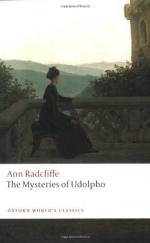|
This section contains 6,025 words (approx. 21 pages at 300 words per page) |

|
SOURCE: “Ann Radcliffe in Context: Marking the Boundaries of The Mysteries of Udolpho,” in Eighteenth Century Life, Vol. 10, No. 1, January, 1986, pp. 35-46.
In the following essay, London explains how plot structure and characterization uphold moral and social principles in such works as Henry Fielding's Tom Jones and Radcliffe's The Mysteries of Udolpho.
At the end of Tom Jones Fielding's narrator assures the continued happiness of the eponymous hero by ascribing to him the qualities of “Discretion” and “Prudence.”1 Discretion and Prudence are called into play here to reinforce the conjunction of the epistemological and ethical with the material reality of the estate Tom Jones has inherited. Only enclosed within the boundaries of this estate can be consciously limit possibility to accord with the desirable consonance of providence and prudence. The boundaries of the estate, in other words, image the reconciliation of self and social wisdom and thus impose...
|
This section contains 6,025 words (approx. 21 pages at 300 words per page) |

|


